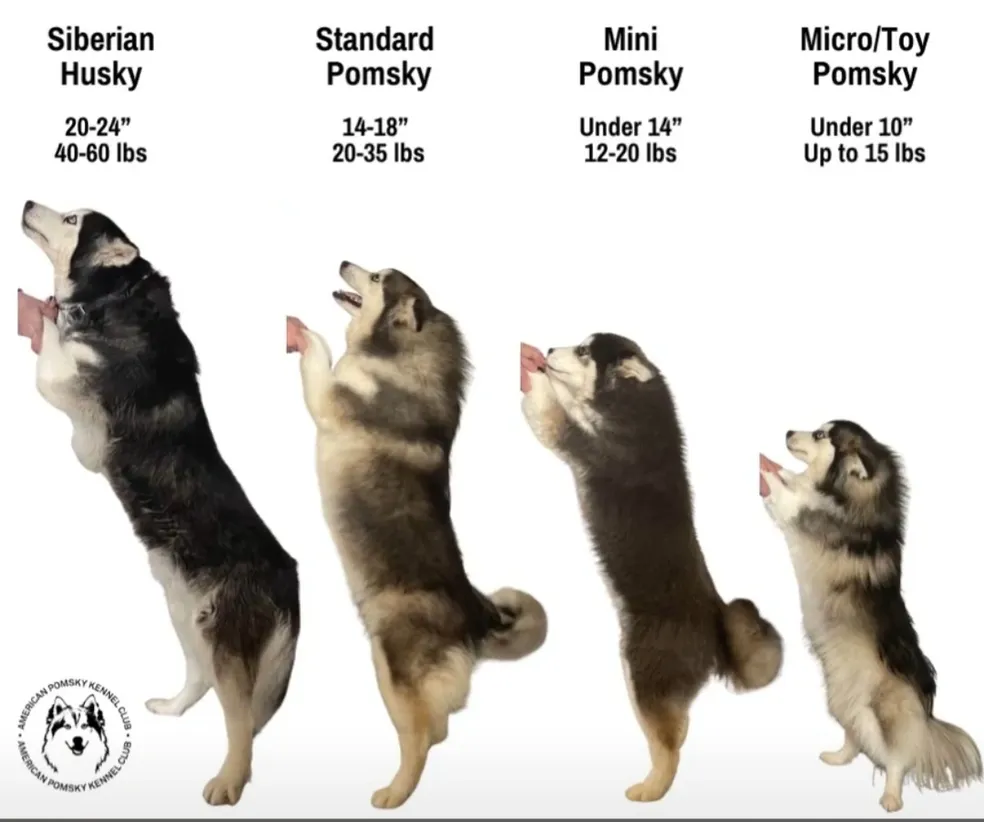
Above are the Husky and Pomsky sizes created for the American Pomsky Kennel Club. Drake's breeder at Clover Ridge Pomskies helped to create the set of photos to demonstrate the size differences.
Drake's grandma, Phoenix is on the far left and Drake's full sibling, Duchess is the second from the right.
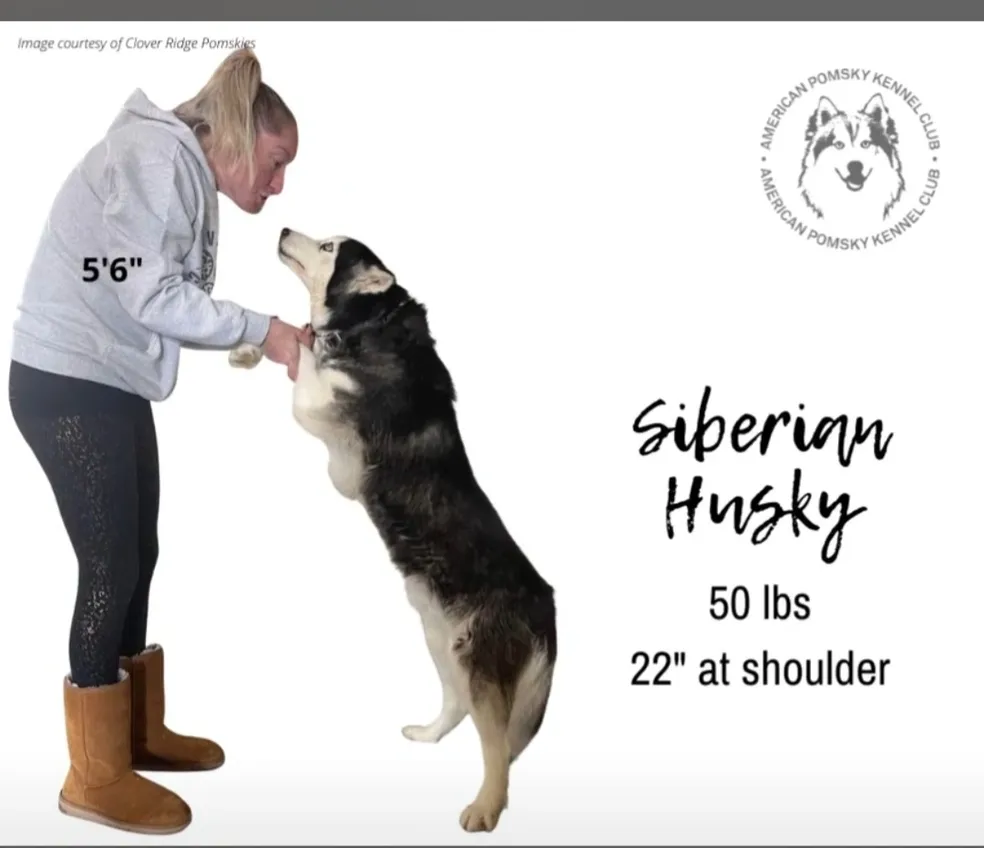
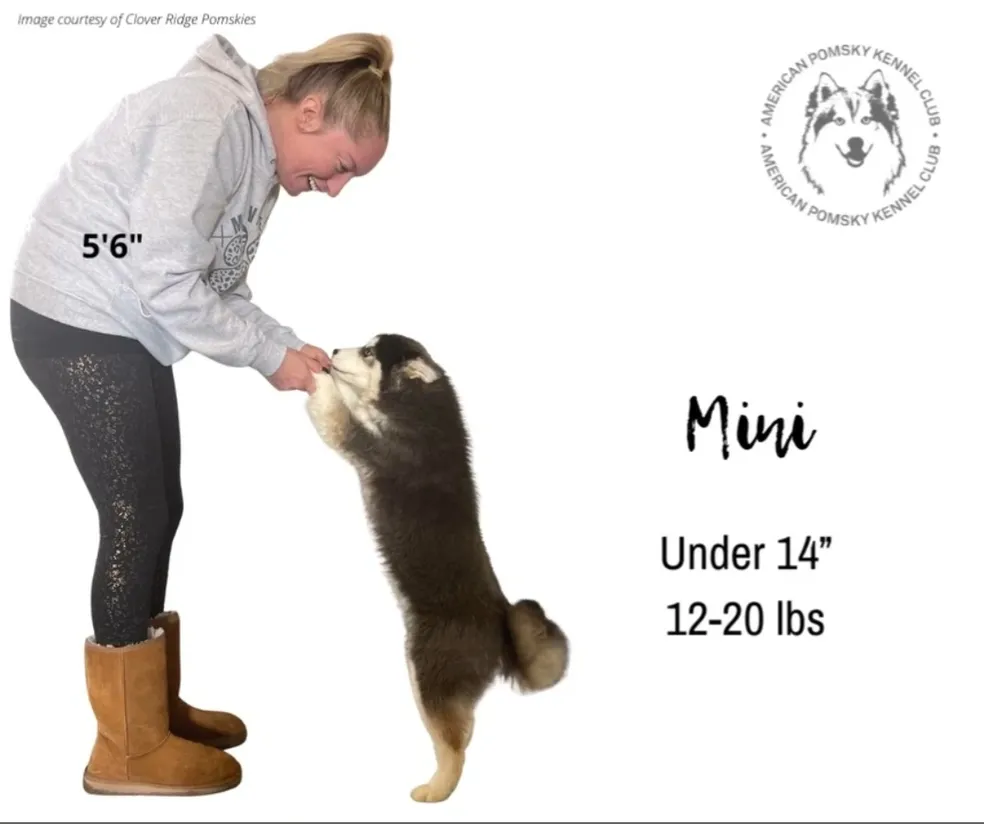
My Dogs and weights
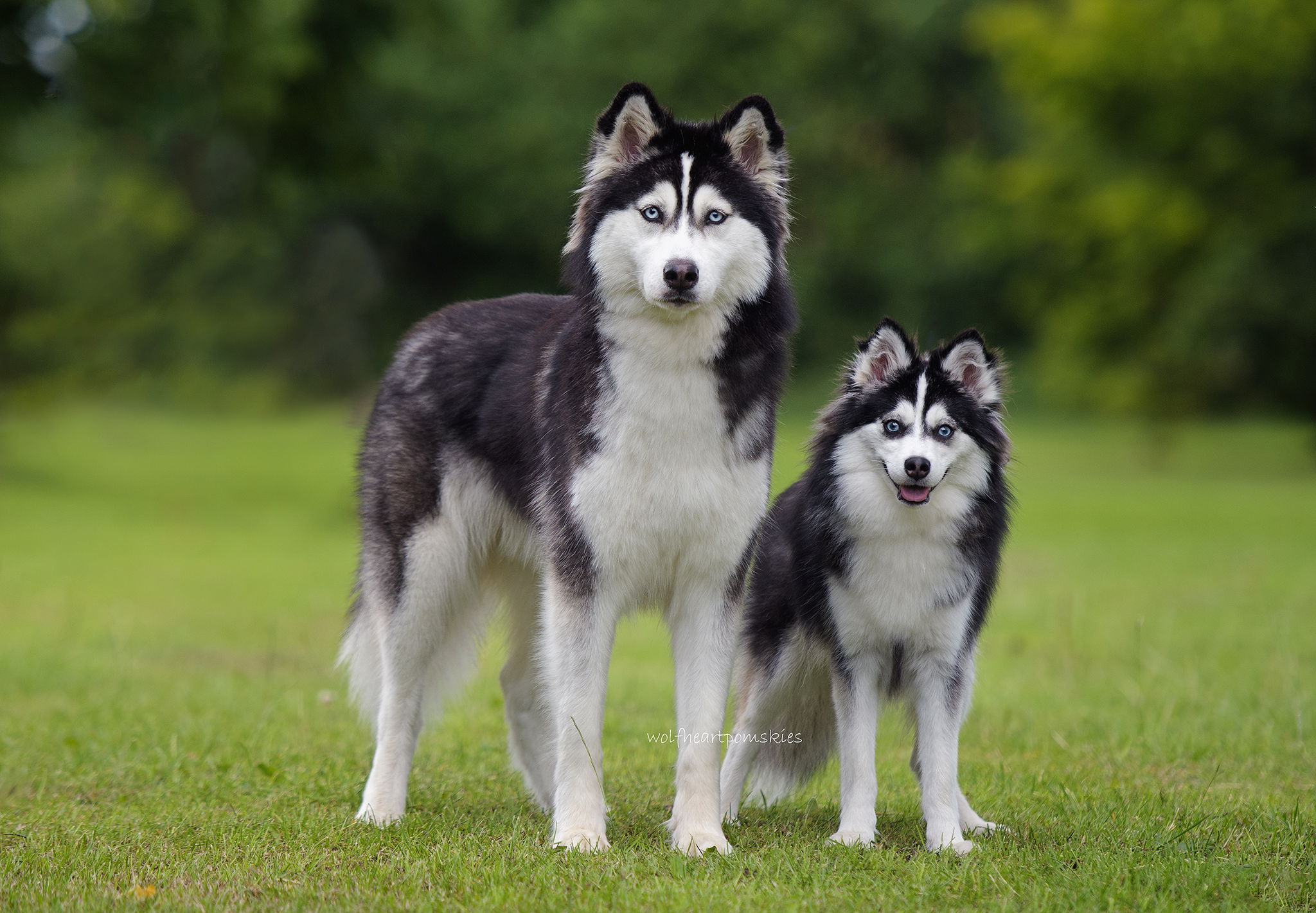
Astra (mostly husky), weighs 19kg and Alaska, Pomsky weighing 8.5kg.
In our pack we have a variety of sizes:
- Astra at 19kg
- Emma at 12kg
- Raven at 9.5kg
- Drake at 9kg
- Alaska at 8.5kg
- Willow at 7.6kg
- Hendrix at 4kg
I would love for someone to help me get photos of them (like the ones at the start) with myself to really show my Pomsky's sizes. Most are around knee height when stood on all fours. Astra standing on her back legs comes up to my shoulders (I am 5 ft4).
In my breeding programme, the adult sizes of puppies from our pairings will be a range but the average weights will be around 9kg.
I cannot guarantee weights but I can provide an idea of their estimated size based on any previous litters and how their weights differ during their first 8 weeks.
I estimated an average of 9kg with Raven and Drake's first litter and I predicted 6 to 8kg for the smaller ones. 5 puppies grew to be in the 6 to 7kg range, Alaska at 8.5kg and Meeko at 13.5kg. I could see his exponential weight growth and I estimated around Emma's weight or a little more. Interestingly, Meeko was the last puppy born and was joint smallest at birth. His weight increased rapidly after the first few days.
Pros and Cons to the Different Sizes
I hear different opinions on sizes frequently and I think it's interesting to hear others experiences and what they deem is the perfect size. I will be honest, I do not think there is a perfect size. They each have their positives and negatives and their temperament is the main thing to consider.
(A large, boisterous dog is going to be a handful compared to a laidback, large dog. A small, calm, confident dog is truly lovely but a snappy, feisty small dog can be hard work).
Bigger dogs/pomskies
- bigger dogs eat more so owners need to consider the cost in their budget. Astra eats up to 5 times more than Hendrix on a daily basis so I feel the cost there. She chews things quickly and some treats I do not give her because they barely take anytime to chew. Hendrix take hours to eat something that would take Astra 1 minute (I wish I was joking).
- they are stronger. They can use their weight to their advantage when on walks and their stride/pace is naturally quicker. People need to consider quality lead training as well as impulsive control training and confidence building in games/training. If they are strong, have a high prey drive and see a squirrel or a rabbit, owners would need to be quick and be able to appropriately handle them to avoid an accident.
- they need more living space and space to run and play. They would need a large bed or crate and owners need to have space for this. Gardens need to be big or of decent size so they can stretch their legs and play.
- their exercise requirements are generally higher than their smaller cousins. We do a mixture of physical and mental exercise and Astra is lovely and settled. She doesn't need hours of walks every day. She does play a lot with the others which helps to tire her. We enjoy using enclosed fields to let them run, play and tire themselves.
- they need a decent amount of space in the car. We have a large boot that works for us. The Pomskies can fit in a seat with a harness but Astra is too big to sit comfortably in 1 seat.
- if using a grooming table, they need a bigger table with a strong bar at the top.
- sounds a little daft but owners have to be strong. Not just to handle them on walks but also when they need to be picked up (for grooming, baths, when they get older and need help getting in and out of the car and if they have an accident). Astra enjoys being picked up even though it isn't easy.. it is difficult to get her in a comfy position due to her large size. She gets jealous of the others being picked up so she asks for the same.
- their size can be intimidating to children and small children could easily get knocked over. Astra is very gentle and naturally knows to approach children with care but excited big dogs do not always understand what is appropriate behaviour around children.
- I find this quite strange but other people have crossed the road to avoid Astra. They see a large dog and avoid. Some have said markings are too wolf-like so naturally feel scared. If they have had a bad experience then I understand. If they looked, saw her happy body posture, tongue lolling out, no facial tension, ears relaxed (and flatten when someone approaches to show she isn't a threat), relaxed tail that will wag happily they would see she is safe to walk by and greet if they wanted. She loves people greeting her and doesn't hesitate to lay on her back for a tummy tickle in the middle of the street.
- their large size means they can reach more and possibly escape. When Astra was younger, we realised she would stand up and take things off the kitchen side. In her mind, she could reach it, it was hers.
- big dogs take up space and enjoy laying in awkward spaces.. based on our experience. We often find Astra on the bottom step of the stairs making it harder to get over her. Sometimes she walks in front of us when walking in the hallway and stops. Sometimes we have to step over her especially as he likes to sleep across the floor in the hallway.
- vet bills are usually higher. Their size means they need more anaesthesia, they need more medical supplies and care during operations so the costs increase.
- I love big dogs. They are a great size to give a big hug (if they feel comfortable), grooming is easier as they don't have tiny, hard to access areas and I find them to be more chilled out. Seeing big dogs run joyfully around is something that fills me with happiness.
Small/toy size Dogs/Pomskies
I never knew how easy it could be to "baby" a dog until I got Hendrix. His small size coupled with his Pomeranian need to be close to me meant I had to really think about certain behaviours and my reactions and behaviour.
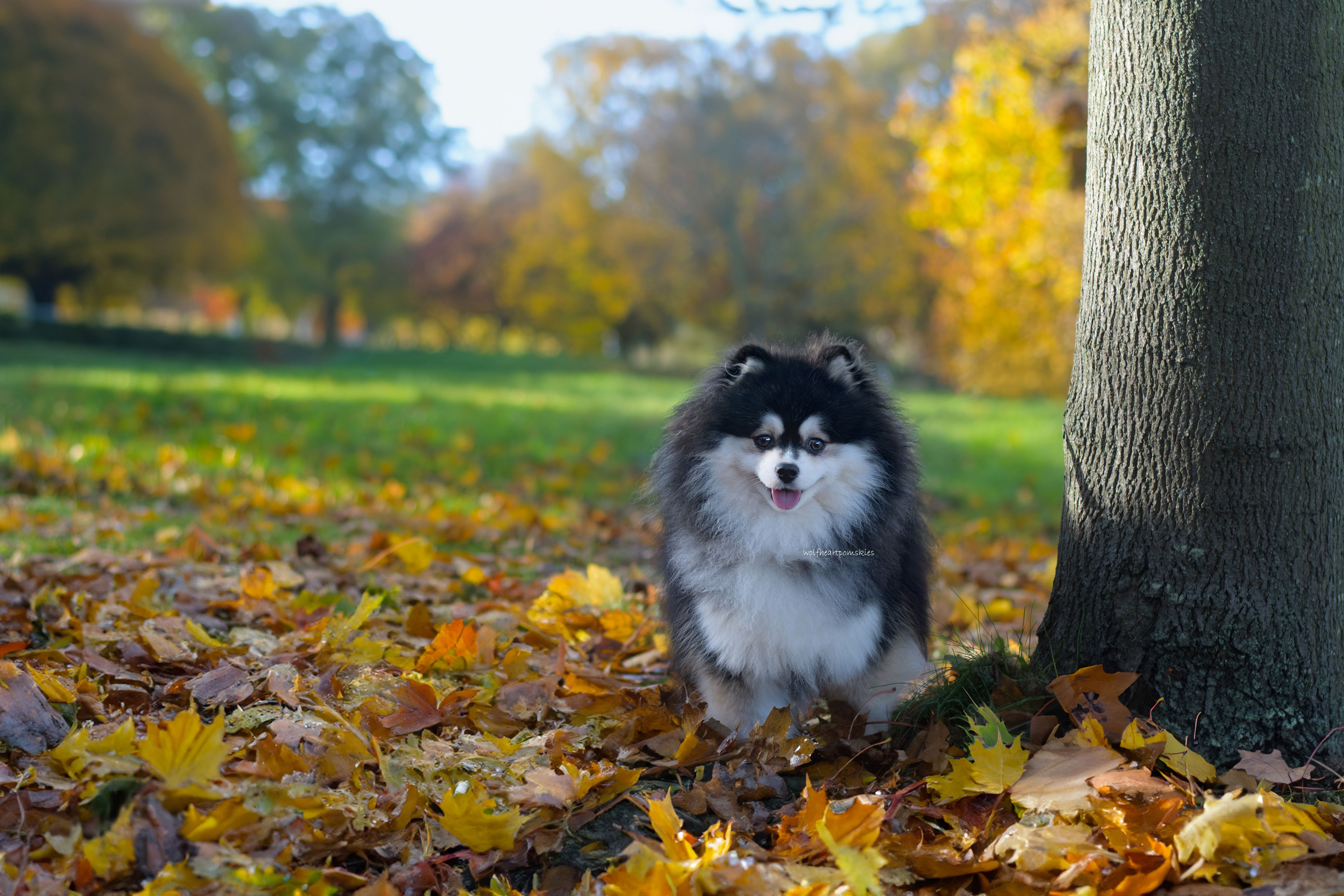
- most small and toy sized dogs were bred to be companion dogs. Their goal in life is to be with their humans. The downsides is that separation anxiety, stranger awareness, territorial behaviour and guarding their humans plays a part in their traits. Hendrix tried to growl at the other dogs when they came close to me when he started to settle in. I moved him away from me every time. I do know some people find this funny with their dogs and do not know how to stop this behaviour and some do not want to stop this behaviour. Sadly this leads to the dog thinking they can and have to guard their human and it can lead to extreme behaviours. I enjoy watching dog programmes and have seen cases where a new human baby becomes a challenge for the pups affections and owners try to rehome the dog that has been the baby for long time. I have seen extreme cases where dogs have been put to sleep as noone but the original owner could get close to the dog. Dogs need to understand they are dogs and not our furry babies. It's harder than some may think. I chastise myself when I have done something that may be classed as babying Hendrix.
- small dog syndrome is real. They are small and everything towers over them. It is scary! With good quality socialisation, they can be the best dogs. Small dogs meeting large and giant breeds can be a terrifying experience for them and some owners feel the need to pick their dog up.... sadly this changes the dynamics and gives the wrong signals to the dog. They start to think the other dogs are scary, humans need to hold me and I need to protect them. As long as the bigger dogs temperament is known, it is a safe and a great experience for the small dog to interact. Hendrix was well socialised before living with me and he does not hesitate meeting large breeds. He has been nose to nose with dobermans, rottweilers and other large breeds and surprisingly his confidence makes the larger dog back off a little. Some large dogs put Hendrix on alert so we act accordingly without making a big deal. He really enjoys meeting and playing with dogs his size. His first love was a long haired chihuahua called Ruby. They played for such a long time and neither wanted to leave each other.
- due to many being natural fearful of larger dogs, quality socialisation from the start is crucial to helping them interact with other dogs and learn how to read their body language from their small vantage point.
- as some small dogs develop fear based aggression and naturally distrust strangers, it really is worth getting out and about and providing socialisation with other humans. This can be anything from a walk in a park to the high street. (Just be mindful of how busy it is when building it up and don't be afraid to ask people not to approach whilst you are training your dog)
- small dogs weigh less and are easy to pick up when the need arises (vet visits, bathing, grooming tables etc)
- they eat less and feeding costs are a great deal cheaper than bigger dogs.
- though they should be trained on a lead, if they pull they are much less likely to pull you over
- I would love to say they are easy to groom but they have harder to reach areas (around inner thighs, lower waist) and grooming tools need to be small enough to brush their stomachs and sides.
- they can get tired more easily than their larger cousins. I monitor Hendrix's energy levels as he thinks he can keep up with the others. He tries and seems to but I see subtle signs and I know he will get grumpy because he is over-tired and overstimulated.
- if not socialised for different heights, grooming and vet tables can be terrifying as the floor is so far away to them
- their small size means they can fit through tiny gaps and escape. Hendrix hasn't escaped but under that fluff, he has a tiny body and I can imagine him fitting through a tiny gap in a fence.
- I feel smaller sized dogs are generally more alert. They know their size, and will scare off something if they feel threatened. In comparison, larger dogs have their size, they see people naturally back away and smaller dogs are less likely to interact with them. They don't have to be alert because they do not feel threatened like small dogs.
- their size draws more attention when out in public. Unfortunately not everyone knows how to approach dogs and adults are giants to small dogs. A giant suddenly lowering themselves to a tiny dog can be scary and the last thing we want is fear based aggression.
Medium-sized dogs
I feel that medium sized dogs have the best of both worlds but still need all the training and socialisation so they can reach their full potential to be well socialised dogs.
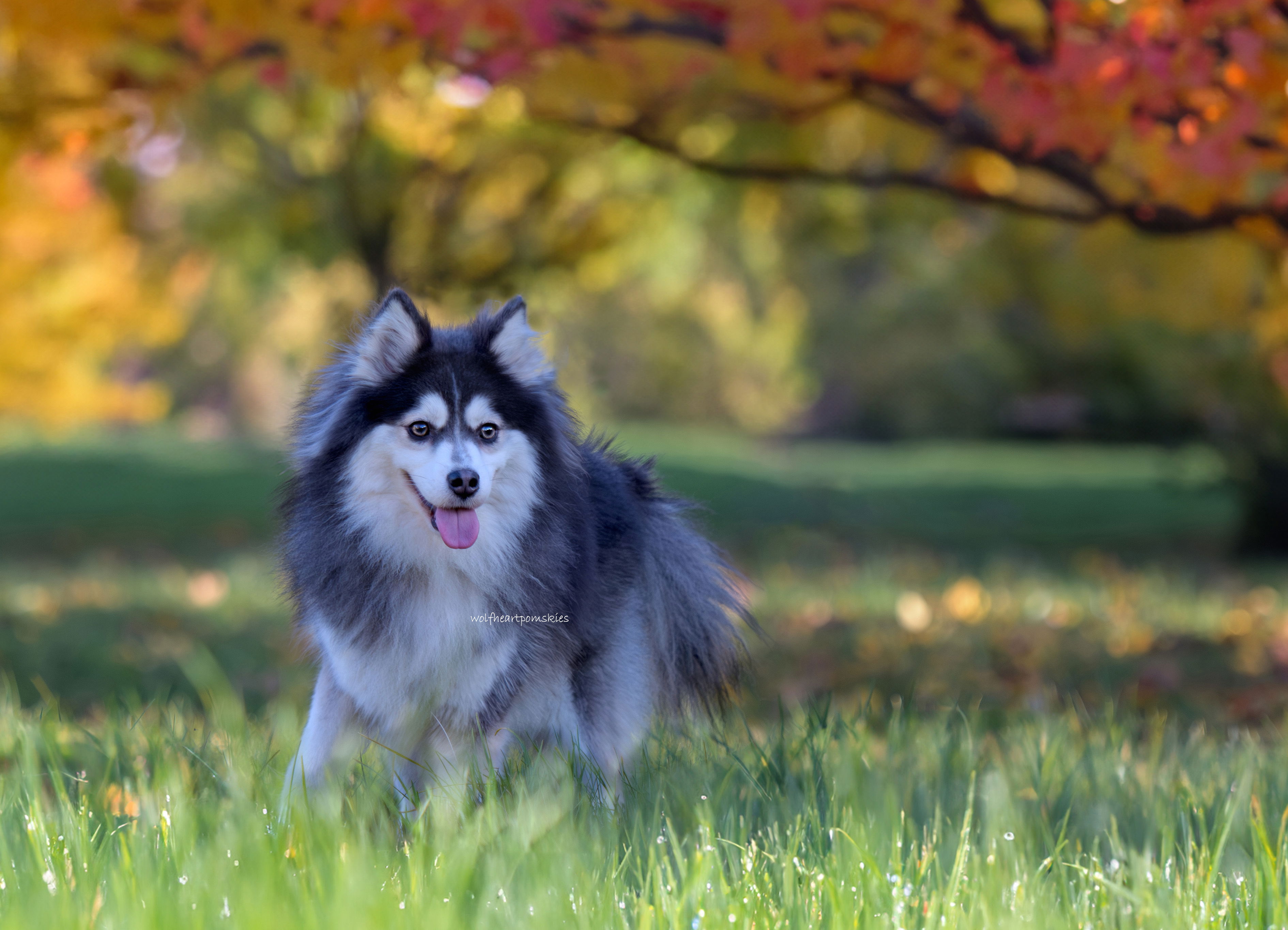
- Some are stronger than they look and can have a surprising amount of strength when they pull.
- I feel their weights and size make them easy to pick up and handle.
- they can manage long walks as long as they have had their stamina built up to handle them.
- depending on their breed, they may have undesirable traits that need to be worked on. A few examples are prey drive, excitability, confidence, recall, jumping up at people. Sometimes mental stimulation can be incredible to calm them down, give them something to focus on, build your bond and concept training can help work in weaker areas of their behaviour.
I don't want to make the post too long and I hope I have covered what I think are key aspects to sizes. All dogs should be well socialised and have training. Some may need more socialisation in particular areas like smaller dogs needing dog socialisation with a variety of sizes and shapes and humans to avoid fear of strangers. Larger dogs may need more boundary training to avoid them counter surfing and stealing anything they can reach.
I do want to highlight this image I searched for- strangers and approaching unfamiliar dogs. Many people do not understand how to approach a dog appropriately. Most of the pack would tolerate a stranger suddenly getting in their space but a few wouldn't like it. They would jump back at the intrusion, yip or bark. Never be afraid to ask a stranger to step back and approach your dog in a more appropriate manner or just walk on by. We need to protect our dogs and avoid stressful situations that may impact their behaviour and understanding.
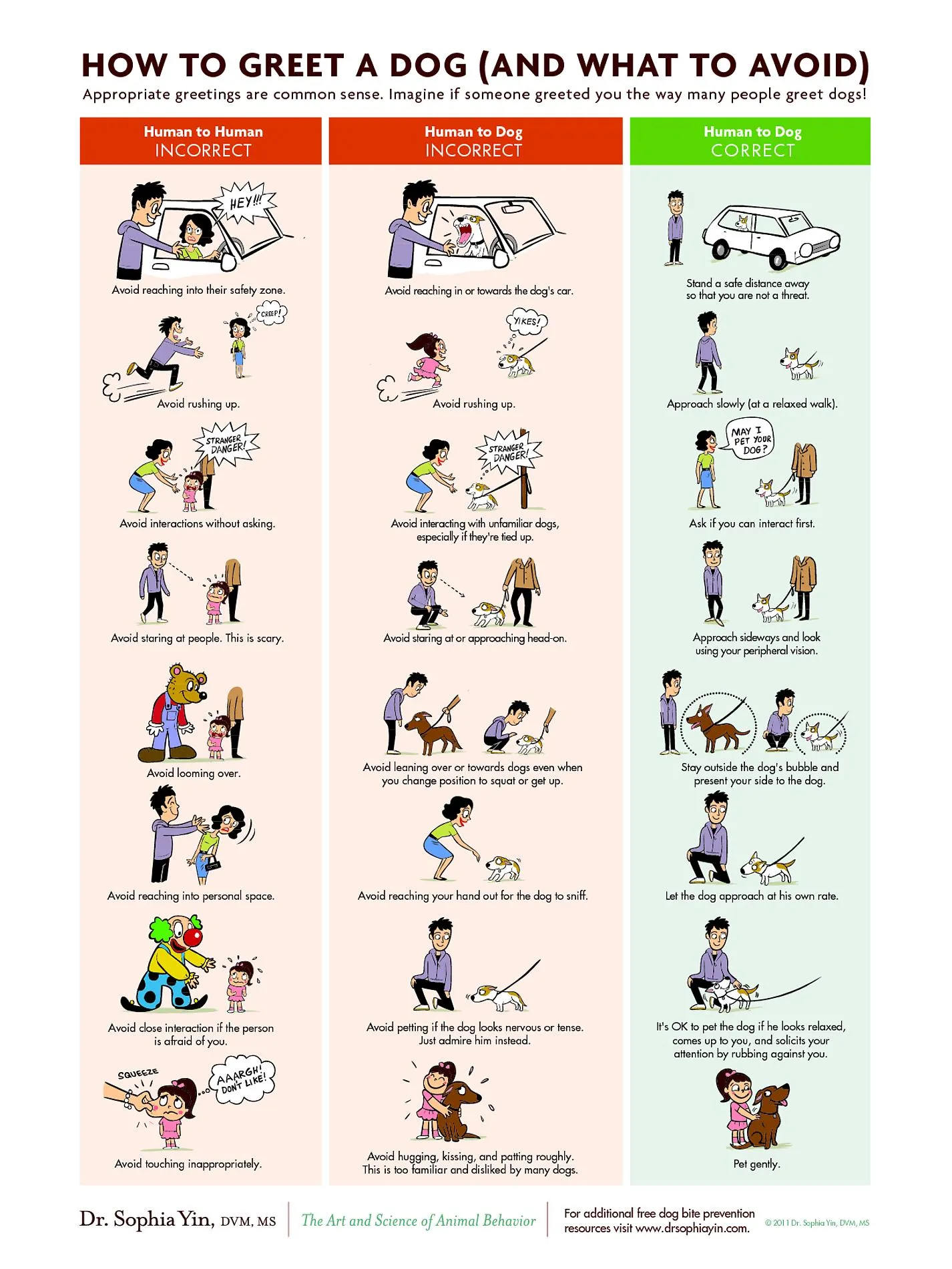
Claire 🐾